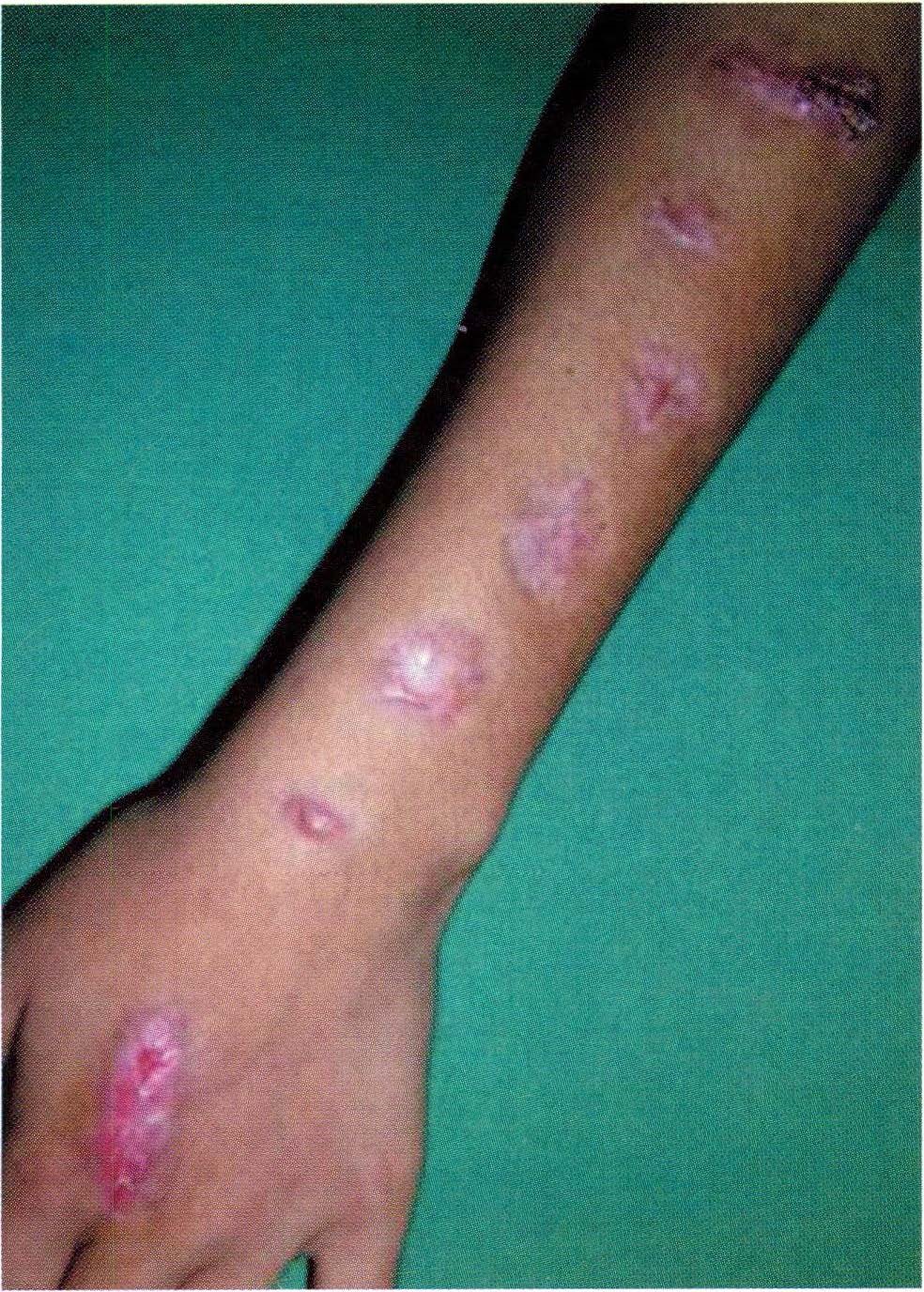Dermatosis ocupacionales
Palabras clave:
dermatosis ocupacionales, dermatitis de contacto ocupacionalResumen
En general, las dermatosis ocupacionales se asocian con un pobre pronóstico clínico y tienen un costo económico considerable para el individuo y la sociedad.
Las presentaciones clínicas son múltiples, siendo más frecuente la dermatitis de contacto. El conocimiento adecuado de estas entidades permite un diagnóstico y tratamiento oportunos para evitar la perpetuación de la enfermedad y un mayor impacto económico negativo. Merece la pena destacar el papel que desempeña la dermatología ocupacional dentro de la medicina laboral, con el aporte de estrategias eficaces para su prevención.
Biografía del autor/a
Giovanna Fernanda Osorio Gómez, Universidad del Valle
RII Dermatologla Universidad del Valle, Calt; Colombia.
Referencias bibliográficas
2. Lushniak BD. Occupational Contact Dermatitis. Dermatol Ther 2004; 17(3):272-7.
https://doi.org/10.1111/j.1396-0296.2004.04032.x
3. Marks JG, Elsner P, DeLeo V. Etiology of Occupational Skin Disease. En: Contact & Occupational Dermatology, 3a. ed. Mosby, lnc. St Louis, Missouri, 2002.
https://doi.org/10.1016/B978-0-323-01473-1.50016-4
4. Rodríguez-Serna M. Dermatitis de contacto irritativa profesional: causas, prevención y tratamiento. Piel 2003; 18(4):189-204.
https://doi.org/10.1016/S0213-9251(03)72695-1
5. Rycroft RJG. Occupational Dermatoses. Rook, Wilkinson, Ebling Textbook of Dermatology 6a. ed. Malden, Blackwell Science 1998: 861-881.
6. Adams RM. Occupational Skin Disease. Fitzpatrick's Dermatology in General Medicine, 5a. ed. New York, McGraw-Hill 1999: 1609-1633.
7. Bocinar MG, Miller OF, Tyler WB. Facial orf. J Am Acad Dermatol 1999; 40: 815-7.
8. Letzel S, Drexler H. Occupational related tumors in tar refinery workers. J Am Acad Deramatol 1998; 39: 712- 20.
https://doi.org/10.1016/S0190-9622(98)70043-X
9. Boissy R, Manga P. On the Etiology of Contact/Occupational Vitiligo. Pigment Cell Res 2004; 17(3): 208- 214.
https://doi.org/10.1111/j.1600-0749.2004.00130.x
10. Sun CC. Allergic contact dermatitis of the tace from con act with nickel and ammoniated mercury in spectacle trames and skin lightening creams. Contact Dermatitis 1987; 88: 77-82.
https://doi.org/10.1111/j.1600-0536.1987.tb01483.x
11. Selvaag E. Chloroquine-induced vitiligo. A case report and review of the literature. Acta Derm Venereol 1996; 76: 166-167.
12. Cummings MP, Nordlund JJ. Chemical leukoderma: fact or fancy. Am J Contact Dermatitis 1995; 6: 122-127.
https://doi.org/10.1016/1046-199X(95)90112-4
13. Vermeer M, Bruynzeel D. Mouse fingers, a new computer-related skin disorder. J Am Acad Dermatol 2001; 45(3): 477.
https://doi.org/10.1067/mjd.2001.114567
14. Lewis AT, Hsu S, Phillips RM, Lee JA. Computer Palms. J Am Acad Dermatol 2000; 42: 1073-1075.
https://doi.org/10.1067/mjd.2000.105166
15. DeLeo VA. Photocontact dermatitis. Dermatol Therapy 2004; 17(4): 279-301.
https://doi.org/10.1111/j.1396-0296.2004.04026.x
16. Kucenic MJ, Belsito DV. Occupational allergic contact dermatitis is more prevalen! than irritan! contact dermatitis: A 5-year study. J Am Acad Dermatol 2002; 46: 698-9.
https://doi.org/10.1067/mjd.2002.118561
17. Elston D, Ahmed D, Watsky K, Schwarzenberger K. Hand dermatitis J Am Acad Dermatol 2002; 47: 291-9.
https://doi.org/10.1067/mjd.2002.122757
18. Goon A, Goh CL. Epidemiology of occupational skin disease in Singapore 1989 - 1998. Contact dermatitis 2000; 43: 133-136.
https://doi.org/10.1034/j.1600-0536.2000.043003133.x
19. Antezana M, Parker F. Occupational Contact Dermatitis. lmmunology and Allergy Clinics of NA 2003; 23(2): 269-698-9.
https://doi.org/10.1016/S0889-8561(03)00027-4
20. Grimalt F. Pronóstico, prevención y tratamiento de las dermatitis profesinales. García A, Conde-Salazar L, Jiménez JM, eds. Tratado de Dermatosis Profesionales. Madrid: Eudema, 1987: 517-28.
21. Jappe U, Bonnekoh B, Hausen BM, Gollnick H. Garlicrelated dermatoses: case report and review of the literature. Am J Contact Dermat 1999; 10(1): 37-39.
https://doi.org/10.1016/S1046-199X(99)90092-1
22. Brancaccio R, Alvarez M. Contact allergy to food. Dermatol Therapy 2004; 17(4): 302-313.
https://doi.org/10.1111/j.1396-0296.2004.04030.x
23. Lee A. Occupational skin disease in hairdressers. Austalas J Dermatol 2001; 42(1 ): 1-6.
https://doi.org/10.1046/j.1440-0960.2001.0463b.x
24. Nettis E. Occupational irritant and allergic contact dermatitis among health workers. Contact Dermatitis 2002; 46(2):101-7.
https://doi.org/10.1034/j.1600-0536.2002.460208.x
25. Hernández N. Los alergenos más famosos en los últimos 4 años. Rev Asoc Col Dermatol 2003; 11 (4): 335- 338.
26. Belsito D. Patch testing with a standard allergen (screening) tray: rewards and risks. Dermatol Therapy 2004; 17: 231-239.
https://doi.org/10.1111/j.1396-0296.2004.04033.x
27. Suneja T, Belsito D. Thimerosal in the detection of clinically relevan! allergic contact reactions J Am Acad Dermatol 2001; 45: 23-7.
https://doi.org/10.1067/mjd.2001.113473
28. Saripalli Y, Achen F, Belsito D. The detection of clinically relevan! contact allergens using a standard screening tray of twenty-three allergens. J Am Acad Dermatol 2003; 49:65-9.
https://doi.org/10.1067/mjd.2003.489
Cómo citar
Descargas

Descargas
Publicado
Cómo citar
Número
Sección
| Estadísticas de artículo | |
|---|---|
| Vistas de resúmenes | |
| Vistas de PDF | |
| Descargas de PDF | |
| Vistas de HTML | |
| Otras vistas | |






